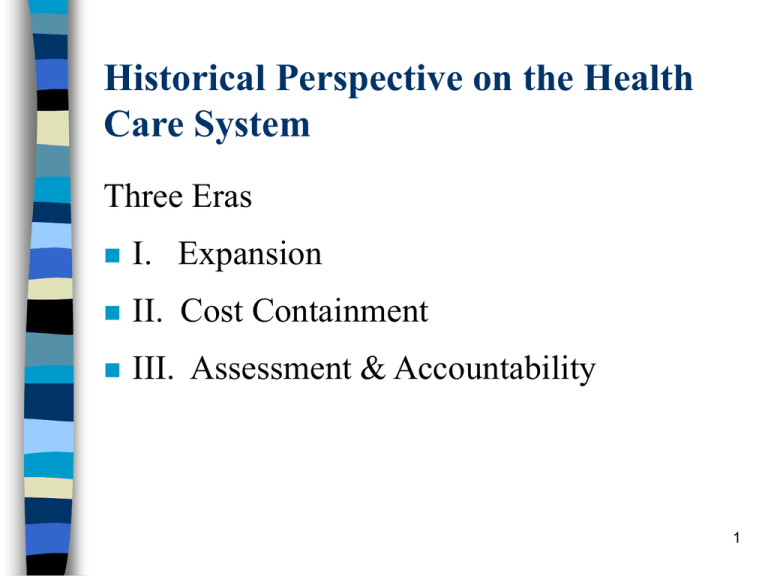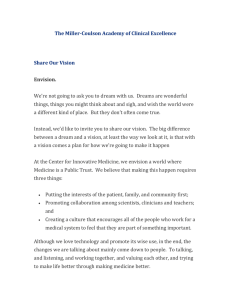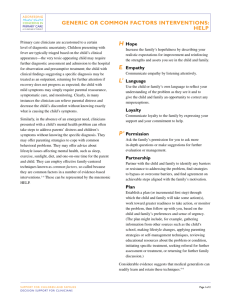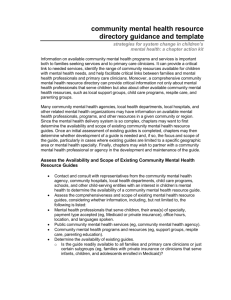Historical Perspective on the Health Care System Three Eras I. Expansion
advertisement

Historical Perspective on the Health Care System Three Eras I. Expansion II. Cost Containment III. Assessment & Accountability 1 Era of Expansion (40’s -60’s) Health care system grew quickly – More hospitals – More private insurance coverage – Numbers of clinicians increased – Advances in technology and science 2 Era of Cost Containment (1965 - 80s) Focus on efforts to curb cost growth – Prior approval Second opinions – Utilization reviews Prospective payment – Managed care - HMOs, PPOs, independent practitioner associations 3 Era of Assessment & Accountability (late 80s - present) Focus broadened Not only cost, but quality of care – Patients, employers, government increasingly requested information – about the value of resources spent on health care 4 Quality of care Most widely accepted view - three dimensions: – structure - characteristics of the settings in which care is provided – process - actions taken on behalf of patients, or by patients – outcome - the effects of care 5 Quality of care Dimensions Structure - the settings and resources used for health care • facilities • equipment • personnel qualifications and experience • staffing patterns • organizational arrangements 6 Quality of care Dimensions Process – the content/act of care • how the patient moves into… • through… • out of…the health care system – the services provided during the episode 7 Quality of care Dimensions Outcome – the results/effect of care • did the patient get better? • was morbidity reduced? • was mortality reduced? 8 “Outcomes” and “effectiveness” (1990’s) Bywords of 1990s efforts Produced by several means – Clinical trials – Insurance claims databases – Meta-analyses 9 Goals for outcomes research Reduce unnecessary use of procedures/modalities of care. • assume that outcomes research can determine what is unnecessary and that these determinations can be applied in individual cases • assume that research is value-free Improve quality of care. • Problem here is the definition and measurement of quality and who defines quality. 10 Goals for outcomes research Reduce cost • Cost probably the driving force for outcomes research (but outcomes research could produce either cost-reducing or cost-enhancing results). • Rationale behind cost-reducing assumption is that there is inappropriate use of technology and use of ineffective technology Provide information for provider/patient decision making • Probably most feasible goal for outcomes research • Assumes clarity/widespread diffusion of findings 11 Health Technology Assessment An old but evolving science and art In a way has been around forever – Observation, trial and error of the clinician What characterizes more recent efforts: • translating findings into “best” practices at the provider/patient level (practice guidelines) 12 Health Technology Assessment Designed to provide clinicians with information on the probability that the drug, device, or procedure is: safe and works improves the patient’s condition – saves lives – Reduces/cures disease – reduces disability – improves quality of life 13 Tradition of Health Technology Assessment - Before the 1970’s (cont.) Formalized assessments of safety and efficacy began in the US Food and Drug legislation in 1923 Creation of the National Institutes of Health (NIH) in 1931 Expansion of federal biomedical research funding after WWII – 1940s – Large-scale, decades-long clinical trails of new treatments for prevalent illnesses 14 Tradition of Health Technology Assessment - the 1970’s (cont.) Major health care issue in the 1970’s defined as escalating costs particularly under Medicare Major belief: that technological advances played a major role in health care inflation Congress, private payers, economists sought to identify causes of/find acceptable solutions to health care inflation 15 Tradition of Health Technology Assessment the 1970’s (cont) “There is an emerging consensus that many technologies have been widely adopted into medical practice in the face of disturbingly scanty information about their health benefits, clinical risks, cost effectiveness and social side effects” – 1978 Congressional hearings 16 Tradition of Health Technology Assessment - the 1970’s (cont) In 1972, Congress established the Office of Technology Assessment as an analytic arm of Congress. In 1976, the NIH initiated consensus conferences – synthesize information, bring judgment of professionals and nonprofessionals to bear on technology assessment issues 17 Tradition of Health Technology Assessment - the 1970’s (cont) Technology assessment gained important public recognition in 1978 Congress established the National Center for Health Care Technology (NCHCT) – To advise Medicare on coverage – set priorities for technology assessment – convene and conduct assessments – disseminate findings of technology assessment 18 Tradition of Health Technology Assessment - the 1970’s (cont) Agency for Health Care Policy and Research (AHCPR) now AHRQ (Agency for Healthcare Res and Quality) – took on sponsorship of outcomes research and practice guidelines – conduct large-scale studies of the effectiveness of specific medical technologies – AHRQ oversees the development of practice guidelines 19 Tradition of Health Technology Assessment - the 1970’s - Private sector responses Both the AMA and the Health Industry Manufacturers Association – opposed to the creation/activities of the NCHCT Employers and insurers – began to look to technology assessment for help in constraining costs 20 Tradition of Health Technology Assessment - the 1970’s - Private sector responses Specialty societies, most notably American College of Physicians, undertook studies When NCHCT disbanded in 1982 – other quasi-public efforts made by the IOM (Institute of Medicine) – and the National Academies of Science to maintain a focus on technology assessment 21 Tradition of Health Technology Assessment - the 1970’s - Private sector responses Clinicians and health services researchers at universities and research centers the RAND Corporation and others – turned their attention to what has come to be called outcomes research including studies of variation in patterns of medical practice 22 Tradition of Health Technology Assessment - the 1970’s – Private/public sector responses Other forms of technology assessment were being developed – Meta-analyses, a sophisticated statistical technique, is being used to combine findings of multiple clinical trials – Quality of life measures were developed as a substitute for economic measures • Particularly relevant for dentistry 23 Quality of care Variation in use issues How to know which procedures were “best”? Examined process (procedures) – In the 60’s, in medicine – as way to learn about treatment appropriateness Found considerable variation – in the utilization rates of surgical procedures – within small, similar geographic areas 24 Quality of care Variation in use issues Variation in use Most commonly refers to: different observed levels of per capita consumption of a service – when all the usual explanations have been controlled leaving no obvious explanation except “practice style” 25 Variation in use – a historical perspective Originate in the phenomenon of practice pattern variations described by Wennberg and his associates in a continuing series of studies starting in the mid 70’s – These papers demonstrated substantial geographical variation in the aggregate use of physician and hospital services – And in specific utilization rates of common surgical and radiologic procedures – The authors argued that these variations neither reflect an intrinsic variation in the prevalence of specific conditions, nor are explained by differing patient preferences, What they do represent is still a matter of considerable debate Nevertheless appears to be general agreement that such variations are a symptom of something seriously wrong with our health system – Which should either be addressed for its own sake or as a way of controlling health care costs 26 Quality of care Issues Implications of variation in use Can result in: – under- and over- utilization With cost implications With health implications 27 Quality of care Issues Need to know “best” treatments – only those so categorized would be reimbursed, – thus reducing the amount of ineffective care & its costs Led to development of practice guidelines 28 Evidence-based guidelines Outcomes research Congress began to look to outcomes research – as a means of evaluating medical/dental treatment – as a sound source for the development of practice guidelines 29 Evidence-based guidelines Types of evidence Efficacy - Does the agent “work” under ideal, “laboratory” conditions? Often studied with the randomized clinical trial conducted in highly controlled settings often expensive may present ethical constraints may not reflect the outcomes obtained when used in a typical practice setting 30 Evidence-based guidelines Types of evidence Effectiveness - Does the agent work under ordinary “real life” conditions , i.e., the average DDS for the typical patient? Often studied with clinically-based/ practice-based research designs Examine average providers providing care in average clinical situations 31 Evidence-based guidelines Outcomes research Dimensions of oral health outcomes Drs. Jim Bader & Dan Shugars described four dimensions of oral health outcomes: 1. Physical and physiological dimension– pathology (dental caries, periodontal disease, oral cancer, periapical infection, etc.), pain, & functional capacity 32 Evidence-based guidelines Outcomes research Dimensions of oral health outcomes 2. Psychosocial outcomes of dental care • • • • • aesthetics level of perceived oral health satisfaction with oral status self-concept interpersonal relations – Measured by asking patients about their experience, perceptions 33 Evidence-based guidelines Outcomes research Dimensions of oral health outcomes 3. Longevity and survival of dental restorations, tooth vitality, tooth retention – reflects the survival of dental restorations – time until restoration failure – need for subsequent treatment for same condition 34 Evidence-based guidelines Outcomes research Dimensions of oral health outcomes 4. Economic dimension – Assess the direct and indirect costs – From the patient’s, practitioner’s, purchaser’s, and society’s perspective Cost of dental care – can be an important patient outcome 35 Evidence-based guidelines Outcomes research Summarizing examines the clinical, functional results of a therapeutic intervention as well as the patient’s perceptions of outcome & quality of life 36 Evidence-based guidelines Need for evidence Discovered lack of evidence – Almost no studies of efficacy – Almost no studies of effectiveness – Many guidelines the product of expert opinion Patients’ perceptions of outcomes of treatments – Little known Overall: – Had paucity of information – Had ever-increasing health care expenditures 37 Evidence-based guidelines Need for evidence In 1989 Congress established the agency for Health Care Policy and Research (ACHPR) In 1999, became AHRQ – Agency for Healthcare Research and Quality – to support studies designed to: • reduce variation in tx selection • to assess efficacy/effectiveness of care • to support studies designed to develop program/ clinical guidelines 38 Quality/Hierarchy of Evidence (Guide to Clinical Preventive Services, 2nd ed.) I: Evidence from at least 1 properly randomized controlled trial II-1: …from well-designed controlled trials w/o randomization II-2: …from well-designed cohort or casecontrol analytic studies from >1 research grp II-3: …from multiple time series w/ or w/o the intervention (dramatic results, e.g., penicillin) III: Experts, experience, case reports 39 Strength of Recommendations A: Good evidence to support the rec that condition be considered in periodic hlth exam B: Fair evidence to support rec that be specifically considered C: Insufficient evidence to rec for or against the inclusion of the condition, but rec may be made on other grounds D: Fair evidence to support the rec that be excluded E: Good evidence to support the rec that be excluded 40 Focus on 7 particular worries Biased and defective methodology Unwarranted inferences drawn from the data Patient preferences Clinical experience Unobservable benefits and harms Legal liability Additional tacit motivations 41 Biased and defective methodology Skepticism about the authority behind the outcomes data or practice guidelines – E.g., megatrials vs. administrative databases Methodological objections – the reliability of the sample used – Carelessly organized randomized clinical trials – Mistakenly drawn conclusions from the data Need to ensure the consistency and integrity of the guideline development process 42 Hidden values Charge is made that outcomes data and guidelines reflect hidden, unacknowledged values In the course of low birth weight babies, – One study assessed survivability as a good outcome – Others considered only survival without devastating neurological deficits to be a good result Such difference reflect the different values of the researchers The clinician brings his/her own set of values, as well 43 Patient preferences Many clinicians cite patient preferences as a reason not to abide by recommendations for action associated with outcomes data What if data predict that an intervention will be no more effective than doing nothing – but clinicians believe patient preferences for an action provide an overriding justification for intervening anyway What if some clinicians believe findings that an intervention will have an effect and agree with the finding’s recommendations for action – nevertheless do not proceed when faced with patient resistance, 44 Clinical experience Some clinicians – especially those with years of experience - frequently do not directly dispute the reliability and validity of outcomes data – But still resist the associated recommendations – citing the superiority of their own clinical experience and knowledge A reflection of the claim of dentistry/medicine as art over science – That there is a difference between statistical outcomes in general for a class of patients and what might be effective with a particular patient 45 Doctrine of Individuality As long as clinicians have focused upon the treatment of disease as the “great end of all our studies” Has been recognized that an essential characteristic of medical therapy was that to be conscientious, it could not be routine Two reasons for this: Because the expression of disease varied not only with the nature of the disease by also with the nature of the patient, And because all drugs had many different actions, the risks of the side effects of a drug in a given patient might vary with the patient’s temperament and constitution 46 Doctrine of Individuality At the core of this perspective is the concept that care of the patient must be individualized – No two patients ever have exactly the same disorder Therefore proper treatment must be based not only on the specific or “constant” features of the patient’s disease • But also on a range of personal characteristics that distinguish one patient from another… – And one patient’s personal disorder from another’s 47 Doctrine of individuality This was not to deny any systematic relationship between a patient’s illness and its proper treatment – but rather, to insist that treatment could not be mechanically chosen without attention to a wide range of characteristics – of which the physician would be aware as part of the patient’s personal or family history – or that would be recognized as the disease expressed itself in the particular patient A commitment to the principle of “therapeutic specificity” 48 Unobservable benefits and harms That the data answered some questions, but not their questions – – Consequently the data were less significant to their practice With technologies where clinicians can not directly observe the harm of not intervening – Or the benefits of intervention – (where there is a time gap between the intervention and observable effects) – Or clinicians do not sense an immediate great risk to the patient 49 Fear of liability Clinicians commonly perceive threats of legal liability for either following or not following guideline recommendations – Feel that they can be sued for following too rigidly the outcomes research recommendations – Is unclear whether, and to what extent, clinicians will be held liable for following or not following outcomes data and associated practice guidelines Dangerous to allow fear of liability to paralyze the outcomes movement, especially when some outcomes data demonstrate that some clinical practice is harmful to patients 50 Tacit motivation and unarticulated resistance Fellow clinicians leveled charges against each other – that their colleagues’ stated reasons for a resisting outcomes data and guidelines should not be believed – that their real reasons were: – Profit – Ego – Ignorance Some of the objections offered seem to be rationalizations Also have local pressures, mores, and social dynamics Age is felt to be a factor Economic motivation is felt to be a factor 51



